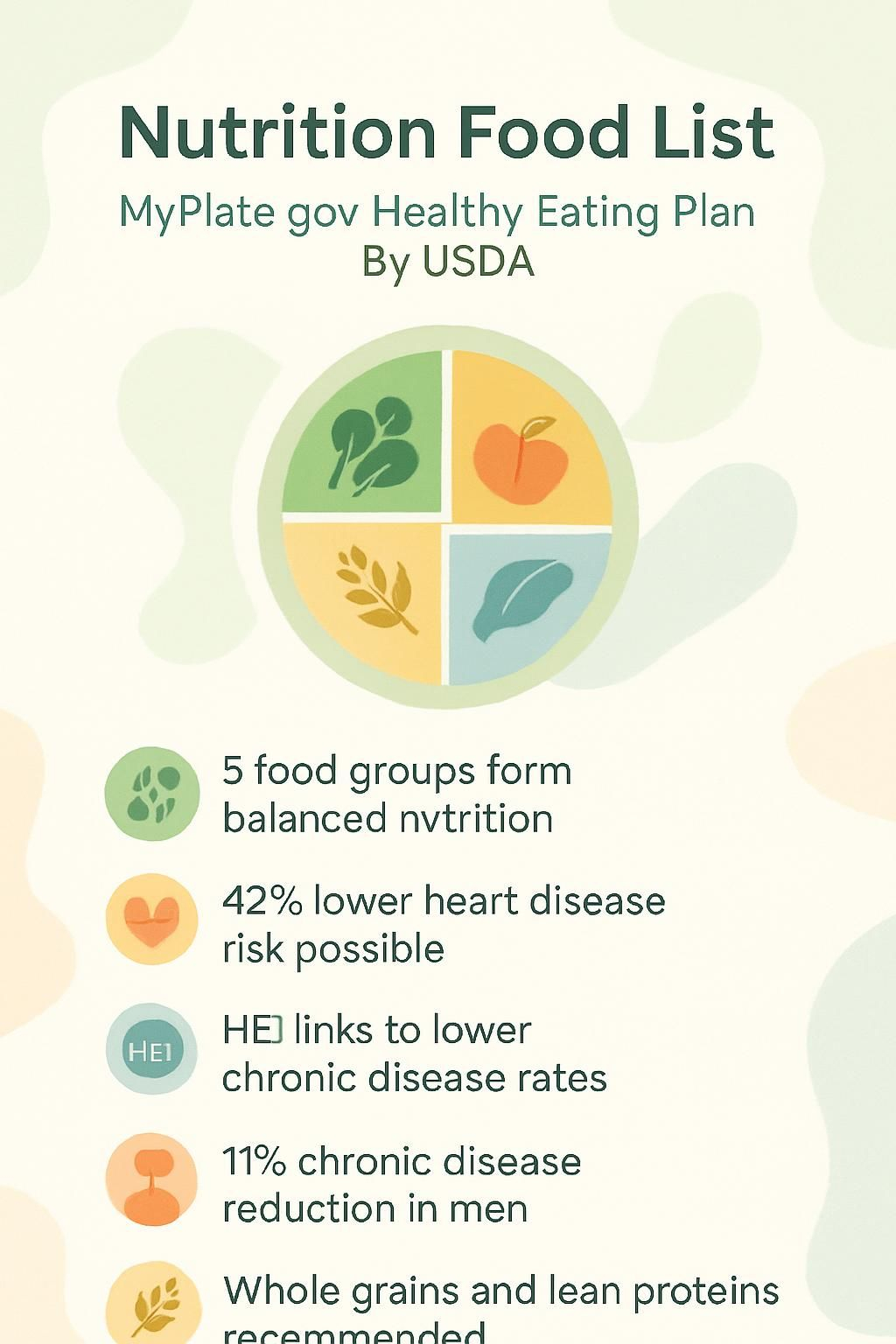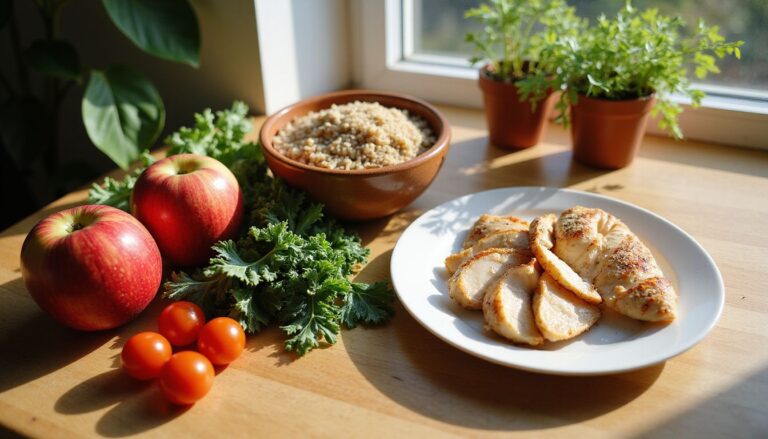Nutrition Food List: MyPlate.gov Healthy Eating Plan By USDA
Our Nutrition Assistant AI Suite will transform your body. You will lose fat, get toned, and build muscle. Gain confidence and optimal health.
Building a balanced meal can feel confusing. MyPlate.gov, from the United States Department of Agriculture, turns healthy eating into simple daily steps. Its Nutrition Food List and food group rules show you how to plan a healthy eating plan without guesswork.
In this guide, you will learn how the USDA Healthy Eating Plan works, which fruits, vegetables, grains, protein foods, and dairy products to choose, and how these choices can cut your risk of heart disease and other chronic conditions. Use these tips to make smarter choices at every meal.
Stay with this guide to turn MyPlate into practical, tasty meals.
Key Takeaways
- The USDA MyPlate.gov model uses five groups, fruits, vegetables, grains, protein foods, and dairy, to balance your plate.
- Filling half your plate with produce most days is linked to lower heart disease risk, with some studies showing reductions up to 42 percent.
- The Healthy Eating Index, or HEI, is a score from 0 to 100 that reflects how closely your eating pattern matches federal dietary guidelines.
- Following USDA-aligned patterns was tied to an 11 percent drop in chronic disease risk for men and a 3 percent drop for women in long-term studies.
- Choosing whole grains, lean proteins, low-fat dairy, and fewer sugary foods lines up with the Dietary Guidelines for Americans 2020-2025.

What is MyPlate. gov?

MyPlate.gov is the official USDA guide to a balanced diet built from nutrient-dense foods. It shows how to enjoy meals with fruits, vegetables, protein foods, dairy products, and whole grains in smart portions you can visualize.
What is the USDA Healthy Eating Plan?
The USDA Healthy Eating Plan offers daily guidance for five food groups, fruits, vegetables, grains, protein foods like meat and legumes, and dairy. It is supported by the Healthy Eating Index, or HEI. The HEI is a research tool created in the 1990s that scores how closely your eating pattern follows federal advice, from 0 for no alignment up to 100 for full alignment.
You can use FoodData Central to check nutrients in common foods such as oats, quinoa, or yogurt. This database links to What We Eat in America, which comes from NHANES, the National Health and Nutrition Examination Survey. Regular updates pull in items from the Global Branded Food Products Database via GDSN, while Label Insight stopped adding new data after November 16, 2023.
These tools help you choose low-fat dairy, switch to whole grain bread over white bread, and limit refined grains and sugary drinks. Making these swaps supports healthy blood pressure and a lower risk of heart problems.
What are the key principles of MyPlate?
Fill half your plate with fruits and vegetables at most meals. Aim for many colors like berries, tomatoes, carrots, melon, leafy greens, celery, zucchini, and salad greens.
Make one quarter of your plate whole grains such as brown rice, barley, or whole wheat pasta. The last quarter is for protein foods. Try skinless poultry, beans and lentils, soy foods, nuts and seeds, fish like sardines or shrimp, or eggs. If you are vegetarian, choose plant proteins often.
Cook with plant oils like olive or canola oil instead of butter. Avoid trans fat, which harms cholesterol levels. Drink water most often. If you use dairy, keep it to one or two servings a day and pick low-fat or fat-free options. Limit sugary beverages and keep juice to a small glass, about 4 ounces per day.
MyPlate also reminds you to stay active each day, which supports digestion and overall health.
“Eat food. Not too much. Mostly plants.” – Michael Pollan
These simple steps set the stage for long-term wellness.
Benefits of Following the MyPlate Healthy Eating Plan
The MyPlate Healthy Eating Plan encourages variety and balance, which supports a healthy weight and may lower the risk of heart disease, high blood pressure, and some cancers. Small changes add up over time.
How does MyPlate promote balanced nutrition?
MyPlate uses clear proportions so you can build balanced meals fast. Fill half your plate with produce like leafy vegetables and colorful fruits rich in antioxidants.
Put whole grains on one quarter of your plate. Options like oats contain beta-glucan, a special fiber that helps manage cholesterol. Use the last quarter for protein foods, such as seafood, eggs, beans, or lean meats, to support muscles and energy.
Choose fat-free or low-fat dairy for calcium and vitamin D with less saturated fat. Use plant oils instead of animal fats to support heart health. Research summarized by the USDA and the National Agricultural Library links these habits with lower risk of heart disease, high blood pressure, some cancers, and obesity.
How does MyPlate support long-term health and wellness?
Daily food choices shape your future health. Studies from Harvard and other groups report that plate-style eating is associated with lower heart disease and lower early death.
In one large study of 93,676 postmenopausal women, those who followed guidance closer to a healthy plate had lower risk of heart problems and heart failure than those eating a low-fat diet alone. Eating from each group promotes steady energy and a healthier gut over time. Cutting sodium, saturated fat, and sugary drinks supports lower cholesterol and fewer chronic issues common in a Western-style diet.
I paired DASH, a plan that lowers blood pressure, with MyPlate for weekday lunches. Adding kale to a quick side salad gave me more fiber with almost no effort.
Following healthy eating patterns like those outlined by MyPlate leads to long-term benefits you can feel every day.
How can MyPlate reduce the risk of chronic diseases?
Eating in line with MyPlate can lower the risk of heart disease and diabetes. In long-term research, men with higher HEI scores had an 11 percent lower risk of chronic disease over 8 to 12 years, and women had a 3 percent lower risk over similar time frames.
Another analysis found that top Alternate HEI scores were tied to a 20 percent drop in total chronic disease for men and almost 40 percent fewer cardiovascular events. Women with top scores showed an 11 percent drop in all chronic disease and nearly 30 percent fewer cardiovascular cases.
Whole foods from each group supply protein, vitamins, minerals, omega-3 fats, antioxidants, and plant compounds called phytonutrients. In an 18-year UK Civil Service study of more than 7,000 adults, nutrient-dense eating was linked to a 25 percent lower overall death rate and 42 percent lower deaths from heart disease.
Choosing whole grains over refined grains increases fiber, which supports steady blood sugar and healthier cholesterol levels. Limiting salty and high-fat processed snacks provides extra protection for long-term health.
Food Groups in MyPlate
MyPlate organizes your daily eating into five groups. Each group brings different nutrients your body needs for energy, growth, and repair.
What fruits are included in MyPlate?
Fruits are a key part of the MyPlate.gov Healthy Eating Plan. Choose a variety to cover your vitamin and fiber needs.
- Apples offer fiber and vitamin C, great for snacks and salads.
- Bananas deliver potassium and vitamin B6 for muscle function and energy.
- Berries like blueberries, strawberries, raspberries, and cherries provide antioxidants that protect your cells.
- Citrus fruits such as oranges, lemons, limes, and grapefruit give vitamin C and folate.
- Grapes contain polyphenols, plant compounds that may help lower cholesterol.
- Melons like cantaloupe and watermelon hydrate you and add vitamins A and C.
- Peaches, pears, plums, mangoes, pineapples, olives, and kiwis bring color, fiber, and vitamins.
- Tomatoes count as fruit and supply vitamin C plus lycopene for heart health.
- Pick fresh or frozen fruit more often than juice to boost fiber.
- Rotate fruit choices each week to avoid boredom and cover more nutrients.
Mixing fruit types across the week supports long-term health and keeps meals interesting.
What vegetables does MyPlate recommend?
Vegetables are rich in fiber and key nutrients while staying low in saturated fat. MyPlate encourages a wide mix of options.
- Broccoli, carrots, cauliflower, and cucumbers deliver vitamins, minerals, and fiber.
- Leafy greens like kale, Swiss chard, collard greens, lettuce, and cabbage supply vitamin K, folate, and antioxidants.
- Cruciferous picks such as broccoli, Brussels sprouts, cauliflower, and cabbage support disease prevention.
- Starchy options like sweet potatoes offer complex carbohydrates for steady energy. Skip French fries in your vegetable half.
- Colorful vegetables, including bell peppers and tomatoes, add vitamin C and flavor.
- Alliums like garlic, onions, and leeks support heart health and are easy to add to many dishes.
- Eggplant and squash bring variety in taste and texture without adding saturated fat.
- Mushrooms add savory flavor and minerals like selenium and potassium.
- Radishes, artichokes, celery, turnips, and zucchini help you rotate choices each week.
- Sprouts provide concentrated nutrients; use them as crunchy toppings.
I started rotating vegetables during busy weeks. My meals became more colorful, and my energy stayed steady.
Which grains are part of MyPlate?
Whole grains are a core part of MyPlate. Aim to make at least half your grains whole for more fiber and nutrients.
- Brown rice supports digestion and helps meals feel more filling.
- Oats supply vitamins, minerals, and soluble fiber that may help with cholesterol.
- Quinoa provides complete protein and all essential amino acids, helpful for plant-focused eating.
- Whole wheat bread or pasta offers complex carbohydrates and B vitamins for longer-lasting fuel.
- Popcorn counts as a whole grain if air-popped with little salt or butter.
- Ezekiel bread uses sprouted grains that may aid digestion and increase fiber.
- Homemade gluten-free or lower-carb breads made with brown rice flour or quinoa flour can meet different needs while keeping fiber.
Use these grains daily to support digestion, even energy, and balanced nutrition.
What are the protein foods in MyPlate?
Protein foods come from both plants and animals. They provide amino acids your body uses to build and repair tissues.
- Chicken breast is a lean choice. Grill or bake it to keep fat lower.
- Fish and seafood such as salmon, shrimp, sardines, trout, clams, oysters, and tuna offer protein and omega-3 fats for heart health.
- Eggs are rich in protein and choline, useful for breakfast or snacks.
- Beans and lentils supply plant protein. Choose kidney beans, lentils, soybeans, and peanuts for variety.
- Lean beef or lamb provide iron, zinc, and vitamin B12. Grass-fed cuts tend to have more omega-3 fatty acids.
- Tofu works well for plant-based meals or if you have lactose intolerance. It contains complete protein.
- Shellfish like shrimp and oysters are low in saturated fat and provide minerals such as zinc.
Round out your plate with dairy foods next to create a full, balanced meal pattern.
Which dairy foods are included in MyPlate?
Dairy offers calcium, protein, and vitamins that support bones and teeth. MyPlate highlights low-fat and fat-free choices.
- Low-fat milk delivers calcium, protein, and key vitamins with fewer calories from fat.
- Fat-free milk provides the same nutrients with even fewer calories.
- Yogurt adds calcium and probiotics, which are helpful bacteria for gut health.
- Cheese counts toward dairy. An equivalent serving can match a cup of milk.
- Choose low-fat or fat-free yogurt and cheese to manage saturated fat.
- Reviews from 2022 suggest dairy intake can support heart health when used in moderation.
- Calcium from milk, cheese, and yogurt supports bone strength across life stages.
- These choices line up with updated food pyramid guidance.
- If you avoid dairy, fortified soy beverages are good alternatives for calcium and vitamin D.
Nutrient-Rich Foods in Each Food Group
Each group contains stand-out foods that deliver more nutrition per bite. Focus on these options most often to build meals with strong benefits.
What are nutrient-rich fruits to eat?
Nutrient-dense fruits supply vitamins, minerals, fiber, and antioxidants. Rotate several each week to cover your bases.
- Apples offer vitamin C and about 4 grams of fiber per medium fruit.
- Bananas provide around 420 milligrams of potassium plus vitamin B6 for energy metabolism.
- Blueberries supply vitamin C and anthocyanins, pigments that help limit cell damage.
- Oranges deliver more than 60 milligrams of vitamin C per fruit, plus folate.
- Strawberries pack vitamin C and manganese. One cup covers your daily vitamin C needs.
- Avocados add healthy fats, fiber, potassium, and vitamins E and K. Use modest portions.
- Grapes provide polyphenols tied to a lower risk of chronic disease.
- Kiwis contain more vitamin C than an orange per serving and add fiber.
- Mangoes give vitamins A and C and support eye and immune health.
- Cherries include vitamin C, fiber, and melatonin, which may help sleep patterns.
- Pears contain nearly 6 grams of fiber per medium fruit and natural sweetness.
Choosing a mix across seasons helps you meet nutrient goals while keeping meals fresh and enjoyable.
What are nutrient-rich vegetables to include?
Vegetables are nutrition powerhouses. These picks give you the most value per serving.
- Dark leafy greens, including kale, Swiss chard, and collards, provide vitamins A, C, and K plus folate and fiber.
- Cruciferous vegetables, such as broccoli, Brussels sprouts, cauliflower, and cabbage, deliver antioxidants linked to disease prevention.
- Bell peppers add vitamin C and potassium. A red pepper can exceed 100 percent of daily vitamin C.
- Carrots supply beta-carotene for eye health and fiber for digestion.
- Asparagus contributes folate and vitamin K for cell growth and bone strength.
- Tomatoes offer lycopene along with vitamin C and potassium.
- Squash varieties like zucchini provide fiber and vitamins A and C with few calories.
- Mushrooms add selenium and B vitamins that support immune function.
- Onions, garlic, leeks, radishes, artichokes, celery, eggplant, lettuce, turnips, and cucumbers bring phytonutrients and fiber for heart health.
Which grains are nutrient-rich choices?
Whole grains deliver fiber and important minerals that support digestion and heart health. Choose these most often.
- Brown rice stands out for fiber, B vitamins, and minerals.
- Oats provide beta-glucan fiber, iron, and magnesium. Enjoy as oatmeal or in simple bars.
- Quinoa supplies all nine essential amino acids and plenty of magnesium.
- Whole grain bread provides more fiber and B vitamins than white bread. Look for 100 percent whole wheat on labels.
- Ezekiel bread uses sprouted grains like barley, millet, and spelt for extra protein and micronutrients.
- Homemade gluten-free or lower-carb breads can include seeds or nuts and less sodium.
- Making half your grains whole is tied to lower heart disease risk in large studies.
I added quinoa and oats last year after reading USDA research on fiber. My digestion improved within weeks, which matches what the data suggests.
What protein foods are nutrient-rich?
Protein foods supply amino acids along with iron, zinc, and other key nutrients. Mix animal and plant sources to get a full range.
- Eggs provide complete protein, about 6 grams per large egg.
- Chicken breast is lean, offering around 26 grams of protein per 3-ounce serving.
- Lean beef adds iron, zinc, and vitamin B12 with about 22 grams of protein per 3 ounces cooked.
- Lamb, especially grass-fed, brings omega-3 fats, iron, and B12. Keep portions moderate.
- Green beans add a small amount of protein with fiber and crunch.
- Kidney beans give about 15 grams of plant protein per cooked cup, plus folate and potassium.
- Lentils deliver about 18 grams of protein per cooked cup with iron and fiber.
- Peanuts supply about 7 grams of protein per ounce along with healthy fats.
- Salmon provides quality protein and omega-3 fats, about 22 grams per 3 ounces.
- Sardines are nutrient dense, with calcium, vitamin D, B12, and around 21 grams of protein per small can.
- Shellfish like shrimp or oysters bring protein, zinc, and B12. Shrimp has about 18 grams per cooked cup.
- Liver and other organ meats are very high in vitamins and minerals. Eat them occasionally.
Combining plant proteins, like lentils, with seafood or poultry across the week supports balance and keeps meals appealing.
Which dairy foods provide key nutrients?
Dairy can deliver calcium, vitamin D, and high-quality protein. These options fit the MyPlate.gov Healthy Eating Plan.
- Milk provides calcium, protein, vitamin D, and potassium. Low-fat and fat-free versions help limit saturated fat.
- Yogurt contains probiotics for gut health along with calcium and vitamin B12. Greek yogurt is higher in protein.
- Cheese such as mozzarella or cheddar supplies calcium and phosphorus for bones.
- Lactose-free milk offers the same nutrients for those with lactose intolerance.
- Fortified soy milk or soy yogurt can replace dairy. Check labels for calcium and vitamin D.
- Cottage cheese is a lean, high-protein snack with fewer calories than many cheeses.
- Kefir adds probiotics plus vitamins A and D and minerals.
- Moderate dairy intake may support heart health based on recent reviews.
- Most teens need about 1,300 milligrams of calcium per day, according to USDA guidance.
I feel more satisfied on busy days when I add Greek yogurt or a low-fat cheese stick to meals. The protein and minerals help me stay full until dinner.
KEYWORDS: Nutrition Food List, Healthy Eating Plan, MyPlate.gov, USDA Healthy Eating Plan
Using MyPlate to Build a Healthy Diet
MyPlate is a practical tool you can use every day. The simple plate graphic makes portioning easier than counting every calorie.
What are the portion recommendations for each food group?
Use these visual cues to build balanced meals without a scale or measuring cup.
- Fill half your plate with fruits and vegetables at each meal. Aim for many colors and skip fries.
- Use one quarter of your plate for whole grains like brown rice, whole wheat bread, or oatmeal.
- Use the last quarter for protein foods, such as beans, chicken, fish, tofu, eggs, or nuts and seeds.
- Have 1 to 2 servings of dairy per day, like a cup of milk or a small yogurt. Choose low-fat or fat-free when possible.
- Keep juice to a small glass, about 4 ounces, and favor whole fruit most days.
- Cook with plant oils sparingly. Use just enough for flavor and texture.
- At dinner, I often plate salad and grilled chicken on half the plate, add brown rice in the last quarter, and pour a small glass of low-fat milk.
These steps match the MyPlate.gov guidance and work across many cuisines.
How can I balance meals using MyPlate?
Balancing meals is easier when you focus on the plate sections. You can apply this method to home cooking or takeout.
- Fill half your plate with fruits and vegetables. Rotate colors and types to boost nutrients.
- Make one quarter grains, choosing whole grains at least half the time.
- Reserve the final quarter for protein foods, from lean meats to beans or tofu.
- Add a serving of low-fat dairy like milk or yogurt for calcium and vitamin D.
- Rotate items within each group to cover more nutrients across the week.
- Use olive or canola oil for cooking and avoid partially hydrogenated oils, which contain trans fat.
- Limit highly refined grains and processed foods that are high in sodium or added sugar.
- Use the MyPlate graphic as a quick guide instead of tracking calories at every meal.
- Adapt family favorites to fit the proportions. Keep the flavors you love.
After my doctor suggested MyPlate last year, I adjusted family dinners without strict measuring. Our plates became more colorful, and planning felt easier.
Incorporating Variety in Your Diet
Variety helps you cover all nutrients and keeps meals satisfying. Think of your week as a rotation, not a repeat.
Why is variety important in a healthy diet?
Eating different foods from all MyPlate.gov groups helps you meet vitamin and mineral needs. The Dietary Guidelines for Americans 2020-2025 encourage variety across fruits, vegetables, grains, protein foods, and dairy.
Each group adds something unique. Legumes bring fiber and minerals. Fish and seafood supply omega-3 fats that support heart and brain health. Research using healthfulness scores in 2021 found legumes, vegetables, fruit, fish or seafood, and dairy among the strongest choices.
Different colors often mean different antioxidants. I have more energy during the week when I trade leafy greens for beans one meal, then pair berries with yogurt at the next.
Dietary Guidelines for Americans 2020-2025
Trijsburg et al., Nature Food (2021)
How can I rotate fruits, vegetables, and proteins?
Rotating foods keeps meals fun and covers more nutrients. Try this simple weekly pattern.
- Choose apples one day, then bananas, berries, grapes, citrus, melons, peaches, or pears later in the week.
- Pick broccoli or carrots today. Use cauliflower or spinach later for a new mix of nutrients.
- Add cucumbers to salads now. Next time use tomatoes or sweet potatoes for different vitamins.
- Make chicken at lunch. Have fish or tofu at dinner to change up protein.
- Use eggs at breakfast, then beans or lentils for another meal to add plant protein.
- Alternate brown rice with whole wheat bread if you include grains that day.
- I plan shopping lists with new produce each week so my family tries more foods.
- Switch cooking methods. Steam vegetables one night and roast them the next to keep textures fresh.
- Pair proteins with varied produce. Try grilled fish with roasted sweet potatoes, then baked chicken with steamed broccoli.
- Track your rotation with a simple chart or the MyPlate.gov app to spot gaps.
Healthy Fats and Oils
Healthy fats support brain, hormone, and heart health. Choosing the right sources helps your body use vitamins A, D, E, and K.
What are good sources of healthy fats?
Focus on unsaturated fats, which are found mostly in plants and fish. These choices fit well with MyPlate.
- Avocados supply monounsaturated fats that support heart health and help absorb fat-soluble vitamins.
- Almonds, walnuts, Brazil nuts, macadamias, and chia seeds provide healthy fats, fiber, and some protein.
- Olive oil offers mostly monounsaturated fat. Use it for salads or light cooking.
- Flaxseeds add plant omega-3 fats. Use them ground in yogurt or oatmeal.
- Walnuts provide alpha-linolenic acid, a plant omega-3 linked to brain health.
- Chia seeds deliver omega-3s and fiber. Sprinkle on cereal or blend into smoothies.
- Coconut oil is mostly saturated fat and can raise LDL cholesterol, so use it sparingly [1].
- Macadamias are high in monounsaturated fat and low in carbs, which fits some eating plans.
- Brazil nuts offer selenium, a mineral many people lack. Limit to a few per day.
- Choose nut butters with no added sugar or oils for a better spread option.
[1] U.S. Department of Agriculture, MyPlate.gov Healthy Eating Plan
What role do healthy fats play in nutrition?
Healthy fats provide essential fatty acids like omega-3s, which help manage inflammation. They also help your body absorb fat-soluble vitamins and protect cells.
Focus on plant oils and nuts instead of animal fats and trans fats. The USDA recommends these swaps to lower the risk of chronic disease. Healthy fats also help you get more from the nutrient-rich foods on the MyPlate list.
Foods to Limit or Avoid
Some foods raise health risks if you eat them too often. Small cutbacks can make a big difference over time.
Why limit refined grains?
Refined grains, such as white bread and pastries, lose fiber, iron, and B vitamins during processing. They can spike blood sugar and leave you hungry soon after eating.
Diets high in refined grains are linked with higher risks of type 2 diabetes and heart disease. MyPlate.gov suggests choosing whole grains, like brown rice or whole wheat bread, for better digestion and steadier energy.
What are the risks of sugary beverages?
Sugary drinks like soda and many fruit drinks add calories without nutrients. They increase the risk of weight gain, diabetes, heart disease, and tooth decay.
CDC data show that people who drink sugary beverages daily have a higher chance of obesity than those who do not. Switching to water, tea, or coffee without added sugar reduces added sugar in your eating plan. I noticed more energy and fewer cravings after replacing soda with water.
This change supports MyPlate’s advice to limit added sugars. Next, watch for salt in processed foods.
Why avoid high-sodium processed foods?
High-sodium processed foods raise the risk of high blood pressure, heart disease, and stroke. The CDC reports that more than 70 percent of sodium in the American diet comes from packaged or restaurant foods.
Processed meats and salty snacks increase intake quickly. A small bag of chips can top 200 milligrams of sodium, and a serving of deli meat can exceed 500 milligrams. Choose fresh options often to manage daily sodium and support long-term health.
Tools and Resources on MyPlate. gov
MyPlate.gov offers free tools that make planning, shopping, and tracking easier. These resources help you turn advice into action.
What interactive meal planners are available?
Several planners and databases on MyPlate.gov streamline weekly meal planning and grocery lists.
- Start Simple with MyPlate offers quick, personalized steps to improve habits.
- The MyPlate Plan tool creates a custom plan using your age, sex, height, weight, and activity level.
- FoodData Central includes advanced search and filters. It works best on desktop.
- The FNS Child Nutrition Database supports school meal standards and is available in FoodData Central.
- MyPlate Kitchen provides recipes, menus, and shopping lists for home or on-the-go meals.
- The MyPlate mobile app lets you track meals and get feedback based on USDA guidance.
- Weekly Meal Planner templates help you plan breakfast, lunch, dinner, and snacks.
- Healthy Eating on a Budget shares money-saving tips and low-cost meal ideas.
I used the MyPlate app for a week and noticed I was short on fruit. The tracker helped me fix that quickly.
Where can I find recipes and grocery shopping tips?
MyPlate.gov and Harvard Health share recipes and shopping advice built on USDA guidance. These sources make it easier to plan meals that meet your goals.
- MyPlate.gov’s Recipes section includes hundreds of tested dishes. Filter by food group, prep time, or needs.
- MyPlate Kitchen can turn recipe picks into a grocery list, which speeds up planning.
- Harvard Health offers science-based tips on shopping, balanced plates, and simple cooking methods.
- Downloadable MyPlate grocery lists organize foods by group, which helps you shop faster.
- Short videos show healthy meals in action. Watching them can build kitchen confidence.
- Both sites feature seasonal produce guides to boost nutrients and lower costs.
- Some planners in the MyPlate app track what goes in your cart, keeping you accountable.
- Plant-forward recipe collections support vegetarian and vegan patterns within USDA guidance.
These tools bring evidence-based ideas to your kitchen and make healthy eating more practical.
How does the MyPlate app help track my diet?
The MyPlate app turns guidance into daily action. It helps you plan, track, and improve with simple visuals.
- Log your meals and snacks to see how you match the five food groups each day.
- Use digital planners to schedule balanced meals for the week.
- View a visual breakdown by group so you can spot gaps or excesses.
- Tap to see nutrient-dense options that fit your habits and preferences.
- Set personal goals for calories or servings to support weight management.
- Get instant feedback with color cues that show if you are in the recommended range.
- See recipe suggestions and quick swaps that improve balance without extra effort.
- Review weekly reports that show trends compared with USDA guidance.
- Receive reminders to log meals and short tips to choose whole grains or skip sugary drinks.
- Sync with other health apps to see how diet and activity work together.
Using the app helps you stay consistent and turns small wins into lasting habits.
Frequently Asked Questions
You may still have questions about using the Nutrition Food List and the Healthy Eating Plan from MyPlate.gov. These answers can help you apply the guidance to your life.
How can I adapt MyPlate for special dietary needs?
Swap foods within each group to meet your needs. For plant-focused eating, fill the protein quarter with beans, lentils, tofu, or tempeh instead of chicken or fish. Use soy milk or fortified plant drinks instead of dairy if you avoid lactose.
For gluten-free meals, try brown rice, quinoa, and other gluten-free whole grains. Rotate fruits and leafy greens to avoid nutrient gaps. The plate visual also works for soups, mixed dishes, and cultural recipes.
Can MyPlate be used for weight loss?
Yes. MyPlate teaches portions and food quality rather than strict calorie counting. You will likely eat larger servings of vegetables and fruits, which are lower in calories and higher in fiber.
Many people find this method flexible for families and daily life. I used the visual guide to add more variety without feeling deprived. Research suggests that nutrient-dense patterns with whole grains, lean proteins, colorful produce, and low-fat dairy support healthy weight management.
How does MyPlate support plant-based diets?
MyPlate welcomes plant proteins like beans, lentils, tofu, nuts, seeds, and whole grains. These foods appear across the model as key nutrient sources.
The plan favors whole and minimally processed foods, which fits a plant-forward pattern. I shifted most of my protein to lentils and black beans in college using MyPlate. Meals stayed balanced and satisfying, and I did not miss key nutrients.
Conclusion
Healthy meals are easier with the MyPlate.gov Healthy Eating Plan from the USDA. You get clear nutrition food lists, helpful meal planners, and trusted data through FoodData Central.
Following MyPlate’s simple steps helps you build a balanced diet each day. Choosing foods from every group supports long-term health and lowers the risk of problems like diabetes and heart disease.
Use the tools and resources to plan smarter shopping and cooking. With small, steady changes, nutritious eating becomes a daily habit for you and your family.
Health information in this article is educational and not medical advice. For personal guidance, talk with a registered dietitian or your healthcare provider.
FAQs
1. What is the MyPlate.gov Healthy Eating Plan by USDA?
The MyPlate.gov Healthy Eating Plan, developed by the United States Department of Agriculture, provides a visual guide to help people build balanced meals using five main food groups: vegetables, fruits, grains, protein foods like beans or eggs, and dairy products such as milk or yogurt. Research from the Centers for Disease Control and Prevention shows that following this plan can improve nutrient intake and support long-term health.
2. Which foods should I include in my daily nutrition list according to MyPlate.gov?
Include a variety of colorful vegetables such as spinach or carrots; whole fruits like apples or oranges; whole grains including brown rice or oatmeal; lean proteins such as chicken breast or tofu; and low-fat dairy items like cottage cheese. According to USDA data from 2020, individuals who eat these foods regularly have lower risks of chronic diseases.
3. How does portion control work with the MyPlate model?
The plate graphic divides your meal into sections: half for vegetables and fruits combined; one quarter for grains (preferably whole); one quarter for protein-rich foods; plus a serving of dairy on the side. A study published in Nutrition Reviews found that using this method helps people manage calorie intake more effectively than guessing portions.
4. Can you share an example of how someone uses this plan each day?
A registered dietitian once shared her routine: she starts breakfast with oatmeal topped with berries and skim milk; lunch includes grilled chicken salad with mixed greens and vinaigrette dressing plus an apple on the side; dinner features baked salmon served over quinoa alongside steamed broccoli with a cup of yogurt afterward. This approach makes it easier to meet nutritional goals while enjoying varied flavors at every meal.
Summary: The MyPlate.gov Healthy Eating Plan encourages eating from all major food groups in balanced amounts each day. Choosing diverse options within each group supports better health outcomes based on scientific evidence provided by trusted organizations like USDA and CDC.







